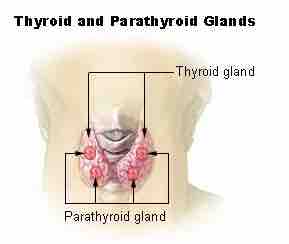The parathyroid glands are small endocrine glands—approximately the size of a grain of rice—in the neck that produce parathyroid hormone. Humans usually have four parathyroid glands, which are usually located on the posterior surface of the thyroid gland, or, in rare cases, within the thyroid gland itself or in the chest.
The two parathyroid glands on each side that are positioned higher are called the superior parathyroid glands, while the lower two are called the inferior parathyroid glands. Occasionally, some individuals may have six, eight, or even more parathyroid glands.

Parathyroid gland
The parathyroid gland in relation to the thyroid gland. They are located on the posterior surface of the lobes.
Parathyroid glands control the amount of calcium in the blood and within the bones. The major function of the parathyroid glands is to maintain the body's calcium level within a very narrow range, so that the nervous and muscular systems can function properly. When blood calcium levels drop below a certain point, calcium-sensing receptors in the parathyroid gland are activated to release parathyroid hormone (PTH) into the blood.
PTH modulates calcium and phosphate homeostasis, as well as bone physiology. PTH has effects antagonistic to those of calcitonin by increasing blood calcium levels by stimulating osteoclasts to break down bone and release calcium. PTH also increases gastrointestinal calcium absorption by activating vitamin D, and promotes calcium conservation by re-absorption in the kidneys.